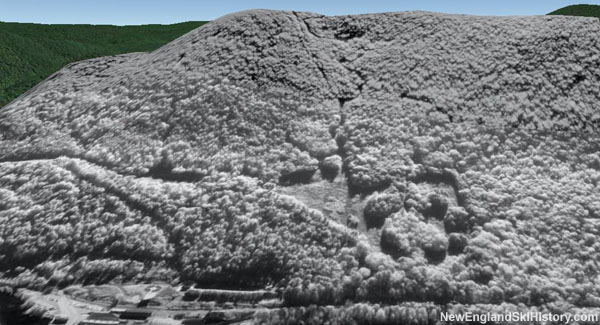
|
| Beartown Mountain |
| Lee, Massachusetts |
| Status: |
Lost/Defunct
|
| First Season: | 1940-41 |
| Last Season: | 1963-64 |
| Vertical Drop: | 820 feet |
| Standing Lifts: | 0 |
| Past Lifts: | Surface lifts |
| Left: Google Earth rendering of Beartown Mountain Ski Area in 1971 |
| Recent NewEnglandSkiIndustry.com News:
|
|
Located in southwestern Massachusetts, Beartown State Forest in Massachusetts was once home to one of the largest ski areas in Southern New England.
Civilian Conservation Corps Development
Circa 1920, the Commonwealth of Massachusetts acquired thousands of acres of land that became Beartown State Forest. Thirteen years later, companies 108 and 112 of the Civilian Conservation Corps (CCC) began working in the forest.
In 1935, plans emerged for a ski development to be constructed by the CCC. Designed by Charles L. Parker, co-founder of the Springfield Ski Club and the Mt. Greylock Ski Club, the alpine development was sited on the north side of the forest adjacent to a railroad station to take advantage of the growing snow train movement. The main 850 vertical foot ski trail was initially to be called the Hurlbut Run in honor of the Hurlbut Paper Company, which offered the use of land at the base of the development.
As the 1935-36 season arrived, the Beartown development was billed as consisting of the East Trail (2,573 feet long by 665 feet vertical), the West Trail (2,237 feet long by 607 feet vertical), and an open slope (889 feet long). By this point, the Hurlbut name was apparently abandoned, as a bear motif was being explored for the new trails; the East Trail was later named Grizzly, the West Trail named Kodiak, and the practice slope was named Polar. To help attract more skiers, the New York, New Haven, and Hartford Railroad allowed the unused South Lee train station to serve as a warming hut and snack bar run by the Stockbridge Ski Club and Lee Rotary Club. Showing their enthusiasm for the project, locals formed the Beartown Ski Club in December with John Waddock serving as its first president.
A trail connecting the town of Stockbridge to the ski area was completed on December 17.
The first snow train was scheduled for mid-January, however a lack of snow resulted in the Beartown stop being cancelled. After some more snow, Beartown's grand opening to snow train passengers was finally held on January 26, 1936, as a crowd estimated at 1,000 gathered (only some 100 were actually on skis). The Berkshire Eagle described the Polar Bear slope as being the most popular, being covered in "pot-holes" as "nine out of ten skiers, thinking discretion the better part of valor, took nose-dives rather than try and worm their way through the swarm of beginners assembled at the base." The crowd was large enough that nearly all of the concession stand's food was sold.
Additional weekend trains came throughout the winter, likely ending on March 8 as the "ski runs basked in near-summer temperature."
Following a successful first winter, superintendent T. E. Battles proposed extending the Polar Bear slope to the summit and adding five new trails and a rope tow. A WPA guide to the Berkshires was released ahead of the season, claiming two tows had been installed on Beartown Mountain, however none actually were for the 1936-37 season. Meanwhile, rope tows continued to gain popularity at nearby Bousquet and Great Barrington Sports Center.
A new trail was reportedly cut by the CCC during the mild winter of 1936-37. Due to a lack of snow, the ski season was likely limited to late March and early April.
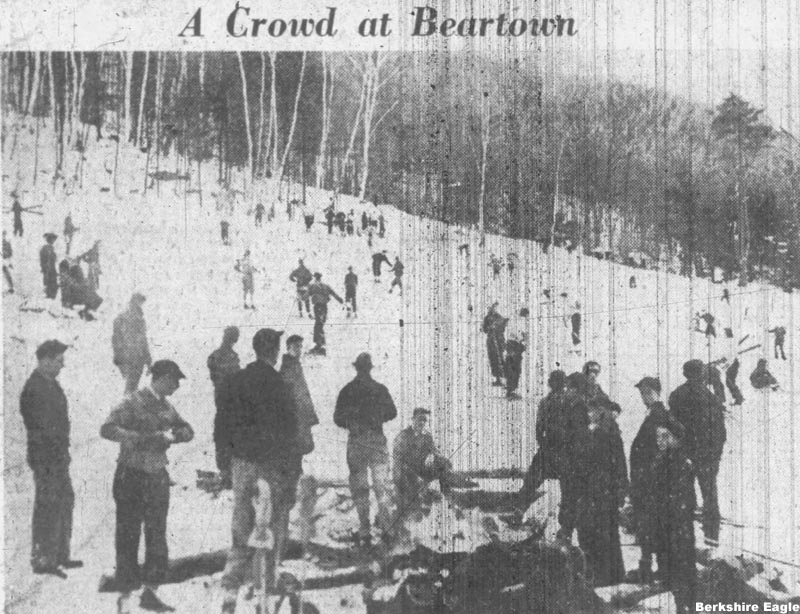
Beartown in January 1938 |
The 1937-38 season was also without lift service, though the state continued to discuss plans for a rope tow. When snowfall allowed, snow trains continued to arrive, with skiers reportedly telling the Berkshire Eagle in January 1938 that "the Beartown runs were the best they have tried." Unfortunately the ski season likely came to a conclusion before the end of February due to lack of snow.
The CCC continued to work on the ski complex in 1938, cutting the 2,000 foot Sedgwick ski trail ("many hairpin loops"), a new ending for Polar Bear (bypassing some steeps), and expanding the slope area. Night skiing may have been offered on one of the slopes. Once again, no lift service was offered. The 1938-39 season featured late November and early April skiing, though at least one February snow train was cancelled due to poor conditions.
Circa the 1939-40 season, William Murthey and Jim Guinan were managing the concession stand at Beartown. After that winter (described by the Berkshire Eagle as the "first real fill of snow since the boom began a half dozen years ago"), the Western Massachusetts Winter Sports Council, chaired by Kenneth Cuddeback, recommended the state construct a ski lodge and rope tow at Beartown.
Lift Service and World War II
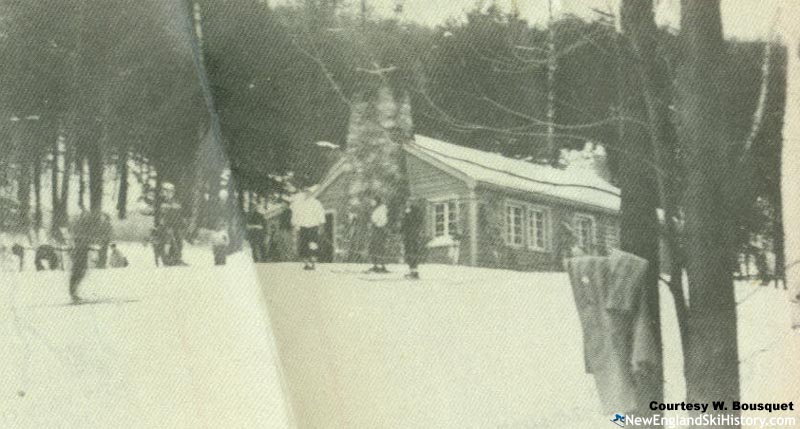
The bottom of the ski area |
In November 1940, the Commonwealth of Massachusetts requested bids for a three-year lease of concessions and rope tow operations at Beartown. A new lodge was constructed at the bottom of the ski area for the 1940-41 season, featuring a stone foundation and hemlock siding, for a total state outlay of $65,000 to this point. The new lodge and 1,400 foot long Underwood Machine Company lift, described as the "most powerful rope ski tow in the east," likely debuted in mid-January 1941. The lift was installed and operated by the American Funicular Corporation of Concord, New Hampshire.
As the build up to World War II accelerated, the CCC presence at Beartown State Forest came to an end in the fall of 1941. Meanwhile, improvements continued at the ski area, including connecting the ski lodge to the Hurlbut Paper Company's water system, and constructing a trestle ten feet above the rope tow so that skiers could go between the bisected slopes. Post-Pearl Harbor World War II and a subpar winter impacted the 1941-42 season, which likely came to an end in March. With snow trains halted and gas rationed, Beartown ceased operating following the 1941-42 season.
Post World War II
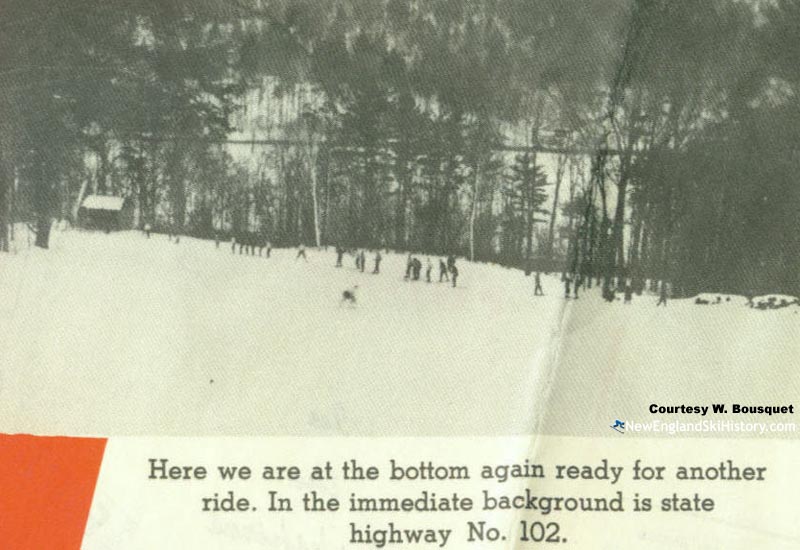
The ski lodge |
Following World War II, American Funicular Corporation resumed operations at Beartown for the 1945-46 season.
A 400 foot novice rope tow was added for the 1946-47 season, with William Murthey likely serving in a management role. Murthey likely served as manager through the 1947-48 season.
During the winter of 1946-47, Frank J. Prinz acquired the former Ascension Farm School, located to the east of the Beartown development. Prinz redeveloped the property as a resort named Oak'n'Spruce in 1947, which included a small rope tow.
Kenton Beaujean took over as Beartown's manager for the 1948-49 season, American Funicular Corporation's second-to-last as operator.
Frank Prinz's brother Albert S. Prinz took over the lease of Beartown for the 1950-51 season, expanding the resort's winter offerings. Beartown was operated mainly on weekends, while Oak'n'Spruce's smaller slope also operated daily and on select nights. Emil Ehrenzeller served as director of the joint ski school.
Lift service was expanded upward for the 1951-52 season, making Beartown one of the largest ski areas in Southern New England with 3 tows spanning 820 vertical feet.
For the 1952-53 season, the Berkshire Ski School conducted classes at Beartown. Unfortunately, the 1952-53 season was a "dud," resulting in "no more than a full week of skiing all winter" according to the Berkshire Eagle.
Formal operation of Beartown was likely suspended following the winter of 1954-55, as the facility was hampered by inadequate parking. Though hundreds used to arrive via snow trains, Beartown only had parking capacity for six vehicles. Frank Prinz unsuccessfully advocated for the state to help make the area more accessible. Hike-up, ski-down usage continued for the rest of the decade at Beartown, including numerous high school races.
Gerald Webber, stationed at Westover Air Force Base, picked up the lease of Beartown for the 1958-59 season, attracting Marsten's Ski Den to operate a rental shop at the ski area. An attempt at alleviating the parking situation involved using a hay wagon as a shuttle to Beartown from a satellite lot. It is possible that the area operated sporadically during the 1959-60 season.
The state announced the area would go out to bid again in the fall of 1960, offering a five-year lease. A permit was reportedly issued to a man from Worcester, however it was revoked when he failed to operate the area that winter.
Beartown Associates
A new bidding process was commenced in spring of 1961 with two groups emerging. The Beartown Ski Club, led by James S. Cobb, was based in Stockbridge and hoped to operate the area as a club open to the public, while a competing Lenox group, led by selectman and businessman William T. McCormack, hoped to operate the area commercially while also appealing to school groups. State commissioner of natural resources Charles H.W. Foster accepted the Lenox group's bid as the highest.
In its winning bid, the group pledged a payment of $75 per year plus 20 percent of profits to the state, plus 5 percent of profits to the local school departments to fund winter sports. The group, which also included local businessman Harold T. Buxton Jr. and ski patroller Albert Cassavant, had been attracted to the development as a result of McCormack's ski racing son's enthusiasm for Beartown. The group planned to operate rope tows for the 1961-62 season, with plans to install a T-Bar or Pomalift in the future.
Around this time, Oak'n'Spruce announced plans to construct a chairlift on Beartown Mountain, likely to the east of the state ski area.
After purchasing a 54 acre tract of land, the new ownership group (now known as Beartown Associates, Inc.) constructed a 25-foot wide access road from Willow Street into the ski area to address the parking capacity issues. Three new dual electric rope tows were installed, though lift service was not provided to the summit on account of steepness. One of the dual rope tows served a new beginner area. Components for the other half of the other dual tows were reportedly on-hand, but not installed (perhaps giving Beartown a total of four lifts).
Opening day was delayed until December 30, as electric transformers reportedly went missing during shipping. Despite the improvements, visitation at Beartown was light in comparison to other regional areas, such as Bousquet, Catamount, and Jiminy Peak. Catamount, Thunder Mountain, Mt. Tom were sporting new chairlifts that season, while Bousquet would follow suit one year later.
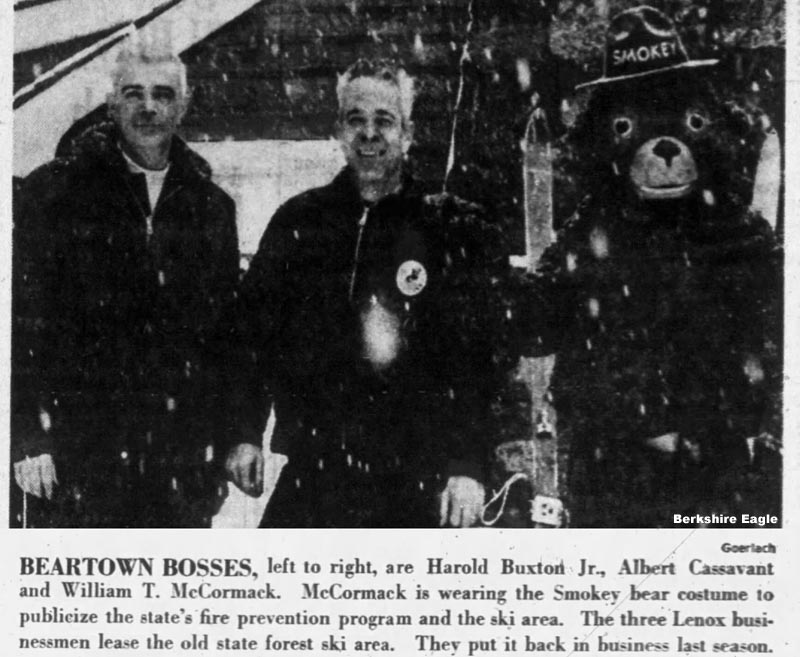
The Beartown Associates group in January 1963 |
For the 1962-63 season, the beginner slope was improved and a fifth rope tow was reportedly added, likely via enabling another one of the dual tows. The weekend and holidays schedule was expanded by offering night skiing on Thursdays through Saturdays. Thor Steinert took over as ski school director, soon organizing a year-end race at the area for all ski school customers.
Novice and intermediate terrain was reportedly improved for the 1963-64 season. Meanwhile, the ownership group began to advertise housing lots for sale adjacent to its access road. A few miles down the road, G-Bar-S Ranch reopened as a chairlift area named Butternut Basin.
Closure
In January of 1964, William McCormack was hospitalized after suffering a back injury while working at the ski area. On one of the last days of operation in mid-March, a skier suffered an injury on the slopes and filed a $100,000 lawsuit against McCormack and Beartown Associates. A few months later, Beartown Associates announced the ski area was discontinuing operations and had reached an agreement to sell its rope tow equipment to the developer of Brodie Mountain.
Discussing the closure with the Berkshire Eagle, McCormack stated, "Beartown is too much of a mountain for rope tows. If we can raise enough capital for a chair lift or a T-bar to go to the top of the mountain, we may open later."
Subsequent Redevelopment Attempts
Hoping to generate capital, Beartown Associates continued its efforts to develop real estate along the access road. William McCormack remained involved with the business, though he put focus into opening the Coffee Break restaurant in 1965. Meanwhile, Beartown's trails continued to be used by race teams (including those under popular local coach Rudy Benedetti) after its closure through at least the winter of 1967-68.
In May 1966, William McCormack announced plans for a $1.5 million redevelopment of the Beartown ski area, including a chairlift to the top of the mountain and two T-Bar lifts. Condominiums would have been developed along the access road on the company's land. A request for a state permit was reportedly denied due to the drama surrounding the contentious Saddleback and Mt. Greylock proposals. Eleven years later, the Town of Lee took the land for non-payment of taxes.
In 1979, Oak'n'Spruce announced new plans to expand onto land held on Beartown Mountain. The buildout would have included three chairlifts and snowmaking, as well as elaborate cross country ski trails.
Beartown trail developer Charles Parker passed away on March 21, 1980 at the age of 75.
Former owner William McCormack passed away on December 31, 1995 at the age of 80. His business partner Harold Buxton passed away on July 7, 2001 at the age of 77. The last of the Beartown Associates trio, Albert Cassavant, passed away on January 11, 2008 at the age of 87.
Though the ski trails have long since been reclaimed by forest, remains of some buildings can still be found.
CCC Trails
Expansion History
Image Gallery
Maps
Year by Year History
Adult Weekend Full Day Lift Ticket; Adult Full Price Unlimited Season Pass. Window price, including RFID fee and taxes when known.
| 1960s |
Ticket Price |
Season Pass Price |
Pass Payback |
Opening Day |
Closing Day |
Skier Visits |
| 1963-64 | $2.50 |  | $25.00 |  | 10.0 days | December 28 | | |  | | | 1962-63 | $2.50 |  | |  | | December 22 | | |  | | | 1961-62 | $2.50 |  | |  | | December 30 | | |  | |
| 1950s |
Ticket Price |
Season Pass Price |
Pass Payback |
Opening Day |
Closing Day |
Skier Visits |
| 1958-59 | |  | |  | | December 20 | | |  | | | 1952-53 | |  | |  | | January 3 | | |  | | | 1950-51 | $1.50 |  | |  | | December 30 | | |  | |
Visitor Memories
| "I was a 12 year old student of Thor Steinert at the Beartown Ski Area. We learned to ski, trained for a year end race, then endured a race course that contained some very painful bamboo race gates! Mr. Steinert, and we students, moved to the Brodie Mtn. Ski Area for the 1963-64 season. " | | William Davis, Apr. 14, 2022 | | "With help from the Western Mass Backcountry alliance the state has cleared the trails at Beartown.
The season ended in the first week of March. Parking is still a problem so be considerate.
There are connections with the x-c trails on the south side.
" | | Neal Chamberlain, Mar. 28, 2022 | | "very interesting operation. recently discovered an old CCC members trunk of memorabilia and 2 photo albums relating to the construction of the ski area. the CCC was a great program, we should have something akin to it today. " | | Kevin Canty, Nov. 6, 2013 |
|
External Links
Beartown Mountain - New England Lost Ski Areas Project
Oak 'N Spruce - New England Lost Ski Areas Project
|
Last updated: May 8, 2021
|



